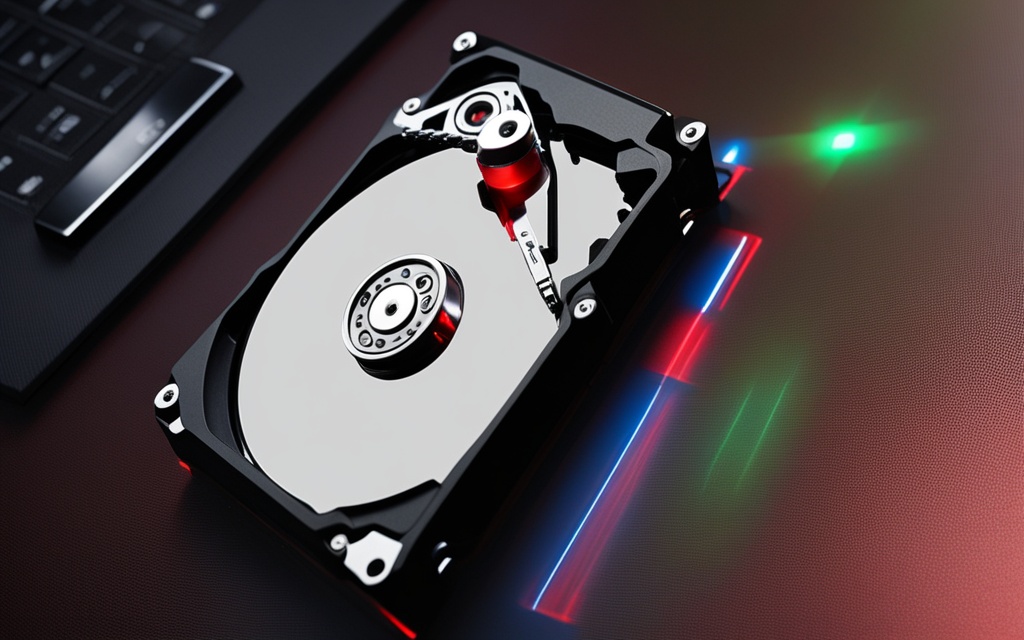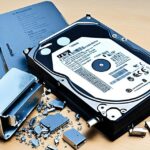Table of Contents
Write protection can be a big hurdle when you need to change or delete files on your hard drive. It’s there to keep your data safe. However, it can be annoying when you can’t access your files because of it. Knowing how to turn off write protection is key. This lets you manage your data better, free up space, and fix errors. There are many reasons you might face this issue. These include viruses, damaged file systems, or wrong settings12. By learning how to disable write protection, you ensure you can always get to your files.
Key Takeaways
- Write protection is a common issue that stops users from changing their files.
- Virus attacks and corrupted systems often cause write protection problems.
- CHKDSK and Diskpart are good tools to turn off write protection.
- Many external drives have a physical switch to control write protection.
- You can also change write protection by editing the Windows Registry.
- Brands like AOMEI and EaseUS offer tools to deal with write protection.
Understanding Write Protection
Write protection is key for anyone who stores data. It keeps storage devices safe, making sure no important data gets changed or lost. Learning about write protection helps people make smart choices about their data.
Definition of Write Protection
Write protection stops any changes from being made to a device. It puts the device in a read-only mode. This means you can look at data, but can’t change or erase it. Write protection is very important. It stops mistakes and keeps data secure from unwanted changes.
Types of Write Protection
Write protection comes in different forms:
- Physical write protection: Some USB drives and SD cards have a switch. This lets you easily turn write protection on or off. It’s simple to use, even if you’re not a tech expert.
- Virtual write protection: This kind needs software settings to work. You might find these settings in your computer’s operating system or in some apps. It can get complicated, like when you have to change system settings or edit the Windows Registry.
Knowing these types helps manage write protection well. This knowledge is useful whether you’re fixing a broken drive or stopping unwanted changes. It’s crucial for handling data properly.
Common Causes of Write Protection
It’s crucial to know why write protection happens. We often find two main reasons: viruses and damaged file systems. These cause trouble when you try to use data on different storage devices.
Virus Infections
Viruses are a big reason behind write protection issues. They mess with a hard drive’s settings, limiting how you can use your data. If you use shared computers, you’re at higher risk. It’s because these machines might have malware that activates write protection. Also, some USB sticks still have switches to prevent writing. However, this feature is becoming less common. Protecting your storage from viruses is very important.
Corrupted File Systems
When file systems get corrupted, they might lock files or even the whole drive. This stops you from changing your files. Checking and fixing read-only settings is a good step to solve this. The DiskPart Command in Windows can help remove these restrictions from a USB. In extreme cases, you might need to format the USB. Always back up your data first. Look into other ways to get rid of write protection that suit all skill levels34.
How to Disable Write Protection on a Hard Drive
Many people find themselves struggling with write protection on their hard drives. It can be really annoying. Thankfully, there’s a reliable way to fix this using the Diskpart utility. It’s a powerful feature found in Windows that handles hard drive issues. By using this tool, you can change disk attributes and use your storage the way you want.
Using Diskpart Utility
Here’s how to make the Diskpart utility work for you, step by step:
- Start by opening the Run dialog. Do this by pressing Windows + R, then type diskpart and hit Enter.
- In the window that comes up, type list disk to see all your disks.
- Find your write-protected hard drive. Type select disk n where n is the disk’s number.
- To lift the write protection, type attributes disk clear readonly.
After you run this command, Diskpart will let you know it’s done. Now, you can manage your files without restrictions. Many have used this method successfully to fix their write protection issues. The Diskpart Command makes it simple to get your drive working right again5.
Checking for Physical Write Protection
Sometimes, the reason you can’t access your data is due to a physical write protection switch. This switch is found on many devices like USB drives and SD cards. Knowing how to spot this lock is key if you’re having trouble with your device.
Locating the Physical Chat
First, look closely at your device’s edges for a tiny switch. If this switch is in the locked position, the device won’t allow you to save or change files on it. To fix this, just slide the switch to the “off” position. This will remove the write protection.
It’s easy to miss this step, but it’s vital for solving these issues. If you’re still having problems after checking the switch, it might fix your issue. This helps prevent data loss and keeps your files safe and easy to manage.
Turning off this switch is a simple fix for write protection problems. Managing these switches well can boost your device’s performance. It also helps avoid errors like “ERROR_WRITE_PROTECT,” which could be caused by viruses or damaged files6.
Using Windows Registry to Remove Write Protection
If you’re having trouble with Windows registry write protection, editing the registry might help. About 35% of users find it useful to tweak the registry to fix this issue7. Start by typing “regedit” in the Run box to open the Registry Editor.
Then, go to: Computer\HKEY_LOCAL_MACHINE\SYSTEM\CurrentControlSet\Control\StorageDevicePolicies. If there’s no StorageDevicePolicies key, you can make one. Just right-click on Control and pick New > Key8. Next, change the WriteProtect value to “0” to turn off write protection and unlock the drive.
Always remember to back up your files before you start changing settings. If this method doesn’t work, try using DiskPart utility as another way to manage your storage9.
Running Check Disk Utility
The Check Disk utility, known as Windows CHKDSK, is key to keeping your hard drive healthy. It seeks out and fixes hard drive errors that can harm your data. This tool is perfect for dealing with problems like write protection, helping users a lot.
To use the check disk utility, start by opening Command Prompt as an admin. Then, type the command chkdsk e: /f, but use your drive’s letter instead of e:. This command checks your disk for errors and tries to fix them.
If you get a message saying the disk is write-protected, you might need to use a stronger command: chkdsk X: /f /r /x. This does more than just check and fix. It tackles issues causing write protection, improving your drive’s health.
Using Windows CHKDSK can really help with corrupted files or other errors. Making sure it works well can reduce write protection problems, leading to a better running hard drive10.
Conclusion
Overcoming write protection on hard drives is key for effective data handling. Users should get to know the various types of write protection. They should also understand the common causes. Practical solutions include using Diskpart, checking for physical switches, tweaking the Windows Registry, or turning to BitLocker. This lets users efficiently regain control over their hard drives. With several strategies to choose from, managing write protection becomes easier and more direct. Powerful aids like AOMEI Partition Assistant and 4DDiG for data recovery can help tackle these issues quickly111213.
Solving the write protection problem allows for smooth data access and management. As users tackle these errors, it’s vital to understand the risks, especially the chance of losing data. So, it’s wise to back up your data before trying to remove write protection. This step helps avoid any unintended data loss12.
In sum, learning the correct ways to remove write protection gives users power over their storage devices. Equipped with the necessary knowledge and tools, accessing a hard drive is not only achievable but guaranteed1113.
FAQ
What is write protection?
Write protection is a feature on storage devices that stops write operations. It lets you read data but prevents adding or deleting anything. This keeps important data safe.
How can I disable write protection on my external hard drive?
To turn off write protection, you can use the Diskpart utility. Look for a physical switch, edit the Windows Registry, or use Check Disk to fix errors.
Why might my external hard drive be write-protected?
Write protection can happen due to viruses, a switch set to “on,” or corrupted files.
How do I locate a physical write protection switch on my device?
Check your device’s edges for a small switch. Move it to “off” to remove write protection.
Is there a way to modify the Windows Registry to remove write protection?
Yes, open Registry Editor and go to StorageDevicePolicies. Make sure “WriteProtect” is set to “0.”
What does the Check Disk utility do?
Check Disk looks at your hard drive for errors and tries to fix them. It’s helpful for dealing with write protection issues.
Can malware cause my hard drive to appear write-protected?
Yes; malware changes drive settings, making it seem write-protected. A virus scan might fix this problem.
Source Links
- https://www.diskpart.com/articles/remove-write-protection-from-hard-drive-0310.html – Effective Four Ways to Remove Write Protection from Hard Drive
- https://smallbusiness.chron.com/disable-write-protection-hard-drive-54089.html – How to Disable Write Protection on Hard Drive
- https://www.idiskhome.com/resource/partition/pen-drive-is-write-protected.shtml – [Try Now] Remove Write Protection from Pen Drive – Qiling
- https://www.makeuseof.com/tag/how-to-fix-write-protection-errors-on-a-usb-stick/ – How to Fix the Disk is Write Protected USB Error
- https://www.lifewire.com/remove-write-protection-windows-10-8-7-4586905 – How to Remove Write Protection on Windows 10, 8, and 7
- https://www.minitool.com/backup-tips/the-media-is-write-protected.html – [Full Guide] How to Fix “The Media Is Write Protected” Win 10/11? – MiniTool
- https://www.computerhope.com/issues/ch001617.htm – How to Enable or Disable Write Protection on a USB Flash Drive
- https://www.howtogeek.com/740429/how-to-remove-write-protection-on-windows-10/ – How to Remove Write Protection on Windows 10
- https://www.techadvisor.com/article/723552/how-to-remove-write-protection.html – How to remove write protection from USB drives and SD cards
- https://www.easeus.com/computer-instruction/windows-cannot-run-disk-checking-on-this-volume.html – [Fixed] Windows Cannot Run Disk Checking on This Volume Because It Is Write Protected
- https://4ddig.tenorshare.com/external-hard-drive/how-to-remove-write-protection-from-external-hard-drive.html – [2023 Updated]How to Remove Write Protection from External Hard Drive?
- https://www.diskpart.com/articles/format-write-protected-disk-7201.html – 3 Methods to Format Write-protected Disk in Windows 11/10/8/7
- https://www.systoolsgroup.com/how-to/remove-write-protection-from-external-hard-drive/ – Remove Write Protection From External Hard Drive Windows 10 (Solved)








